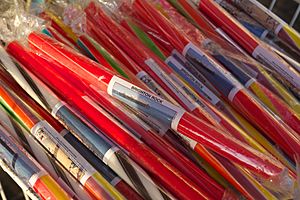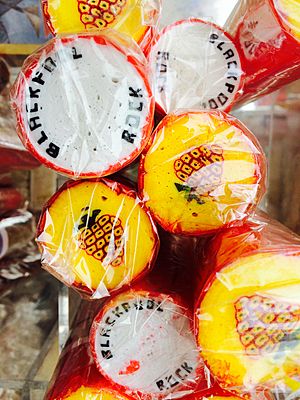Rock (confectionery) facts for kids

Traditional sticks of rock
|
|
| Type | Confectionery |
|---|---|
| Place of origin | United Kingdom |
| Main ingredients | Sugar, flavouring (peppermint or spearmint) |
Rock is a type of hard, stick-shaped candy. It's made from boiled sugar and often tastes like peppermint or spearmint. You'll usually find it sold in UK and Irish seaside towns. Places like Brighton, Blackpool, and Bray are famous for their rock candy.
This candy is usually a cylinder, about 1 to 2.5 centimeters (0.4 to 1 inch) wide. It's also quite long, around 20 to 25 centimeters (8 to 10 inches). Bigger sticks, like those from Blackpool, can be much thicker. They can even be up to 17 centimeters (6.7 inches) wide and 2 meters (6.6 feet) long! What makes rock candy special is the pattern or name inside. This design goes all the way through the stick. So, you can read the name of the town on both ends. Even as you eat it, the name stays visible! Sometimes, rock candy is made for promotions. It might have a company's name running through it. You can also find rock candy as individual sweets. These are basically slices of the larger sticks.
Contents
How Is Rock Candy Made?
Traditional seaside rock candy starts with sugar and glucose syrup. The recipe uses about three parts sugar to one part glucose syrup. These ingredients are mixed in a pan with just enough water to dissolve the sugar. If there's not enough water, the sugar might burn. The mixture is then boiled until it reaches about 147°C (297°F). This temperature is known as "hard crack" stage.
Once boiled, the hot candy mixture is poured onto cool steel plates. Food colors are added for the outer part and the letters. Workers mix these colors by hand using a spoon. As the candy cools, a skin forms underneath. This allows them to cut out the colored parts. They use special shears for this. The colored sections are constantly turned. This stops them from getting lumpy. The rest of the candy mixture stiffens up. Then it goes onto a "pulling" machine.
The Pulling Machine
The pulling machine has one fixed arm and two moving arms. One arm spins clockwise, the other counter-clockwise. This machine helps to add air to the candy. It changes the candy from a solid golden mass. It becomes a soft, white center for the rock stick. While on the machine, flavorings are added. These are poured in carefully measured amounts. A small amount of the white candy is saved. This is used to help keep the shape of the letters. These letters are made from the colored candy.
Making the Letters Inside
The letters inside rock candy are made from thin strips of colored and white candy. When they are first made, each letter is quite large. It's about the size of a thumbprint. This is much bigger than the tiny size you see in the finished candy.
The letters are not made in the order they appear in the word. Instead, they are made based on their shape. "Square" letters like B, E, F, H, J, K, L, M, N, P, R, T, W, X, Y, and Z are made first. These letters hold their shape well. "Triangle" letters (A and V) and "round" letters (C, D, G, O, Q, S, U) are made last. This is because the candy is still soft. Making them last helps them keep their shape. For example, the letters for "BLACKPOOL ROCK" might be made in a different order.
After being shaped, individual letters are placed between blocks or sticks. This stops them from flattening out. Then, the letters are put in the correct spelling order. A strip of white, airy candy is placed between each letter. This makes the word easy to read. Capital letters are most common. Small letters are much harder to make because of their tails and high backs.
Finishing the Candy Stick
The white, aerated candy from the pulling machine is split into three parts. One part forms the center of the stick. The other two parts become the "flaps." These flaps are kneaded and spread out thinly. They are then placed directly onto the letters. These flaps create the space between the outer casing and the letters. They are then wrapped around the stiffened center.
Next, the outer casing is kneaded and rolled out evenly. A rolling pin is used for this. This casing is then wrapped around the whole "boiling." A "boiling" is one very large bar of rock candy. It's usually too thick for a person to hold with their hands. At this stage, it's still soft and warm. This large bar is then put into a "batch roller." This machine has several tapered rollers and heaters. The rollers keep the candy round. The heaters keep it soft enough to work with.
A skilled candy maker, called a sugar boiler, then stretches the large bar. This is called "spinning out." They stretch it onto a long, flat slab. Rollers make sure it keeps rolling until it's hard enough to stay round. This stretching process turns the very thick bar into a much longer and thinner stick. Once it's set, the candy strings are cut to length. They are then wrapped in clear paper with a label. This label often shows a picture of a local landmark. Making lettered rock candy is a skilled hand-made process. Smaller sticks of rock, without letters, can be made by machines.
Other Kinds of Rock Candy
Rock candy is different from rock candy crystals. It's more like a harder version of a candy cane.
Regional Candy Styles
Edinburgh rock is another type of candy from Scotland. It's also made from sugar and cream of tartar. It's crumbly and comes in flavors like ginger or lemon.
Another unique Scottish candy is star rock. It's also called "starry rock" or "starrie." This candy is made in Kirriemuir. It's sold in small bundles of pencil-sized sticks. Star rock is not as brittle as seaside rock.
A similar candy in Japan is called Kintaro Ame.
In the Netherlands, there's a candy called 'zuurstok' (sour stick). It's very similar to rock candy. Like rock candy at the seaside, 'zuurstok' is linked to fairgrounds. It's made similarly to Edinburgh rock. But it comes in different flavors. These often include cream of tartar, making it a bit sour. Other flavors might be cherry, cinnamon, or licorice.




